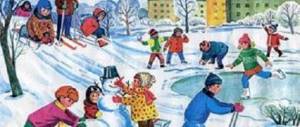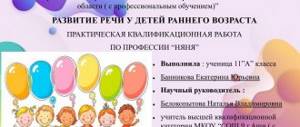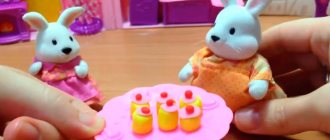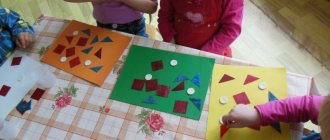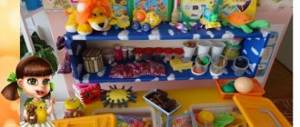Development and education of young children in preschool educational institutions in accordance with the requirements of the Federal State Educational Standard
Preschool education
This article reveals questions about the main features of the development and upbringing of young children. Most often, educators and parents are good allies who organize the educational process in the unity of pedagogical requirements. Therefore, the health of children will depend on how their joint activities are organized.
Article on the topic: “Development and education of young children in preschool educational institutions in accordance with the requirements of the Federal State Educational Standard.”
Early childhood is a special time for the development of children's bodies. Almost all mechanisms in the cerebral cortex do not depend on heredity, but develop directly as a result of the body’s contact with the surrounding reality. This happens especially noticeably in the first three years of life, so it is important to lay the prerequisites for the healthy development of the child in a timely manner.
Professor N.A. Aksarina, being the founder of a nursery, in our country for the first time formed a complex of characteristics of the development of children in early childhood. She argued that the child's body develops at a rapid pace. In no other time period of childhood can such a rapid increase in the mass and length of the child’s body and the development of all brain functions be observed. The rapid pace of formation of a child’s body has its own characteristics. Directly, first of all, this is a spasmodic development. Critical moments in human development - 1 year, 2 years, 3 years, 6-7 years, 12-13 years. It is during these time periods that dramatic changes occur in the formation of new qualities in child development: 1 year is the time of mastering walking; 2 years - the formation of visually effective thinking, a turning point in the development of speech skills; 3 years is a period of clear connection between the child’s behavior and development and the second signaling system, the formation of personal development; 6 - 7 years - the period of maturity for schooling; 12-13 years – puberty, development of gender characteristics of this age. [2; 165].
Spasmodicity reflects the natural, reasonable course of a child’s development. If there are no developmental leaps, then this is a sign of defects in the baby’s development. Consequently, it is very important, while the child is enriching the experience of existence in society, to create effective conditions for the timely formation of a new quality in the development of various functions. It is very important to understand that critical periods involve the child overcoming enormous difficulties and can go in parallel with a decrease in the performance of children and other disorders of the functions of the child’s body. Good care that spares the child’s nervous system, care, and attention help him overcome all the difficulties of this period.
The pace of a child’s development depends on the rapid establishment of connections with the outside world and the slow consolidation of reactions. The skills and abilities of young children are characterized by an unstable and incomplete nature. In this regard, in teaching children it is necessary to use repetition of the material covered, to ensure a connection between the child’s independent work and the adults around him.
Spasmodic development of a young child depends on the maturation of many functions within a certain time frame. N.M. Shchelovanov and N.M. Aksarina, observing this pattern, identified the leading lines in the development of the child, based on the periods in which the baby’s special sensitivity to certain types of influences can be traced. They noted that when raising children, special attention should be paid to the formation of those reactions that mature again or directly for the first time and which cannot be formed independently, without any purposeful actions of an adult. For example, the “revival complex” that is inherent in a baby at 3 months, the ability to use simple sentences in a conversation with an adult at 2 years, the appearance of role-playing games at 3 years.
Due to the rapid pace of development of the body, a child under 3 years of age is characterized by great vulnerability and lability of his internal state. At this age, the baby is susceptible to frequent and sudden illnesses, his emotional state changes dramatically, he gets tired easily, and his nervous system is unstable.
The foundation in teaching young children is the development of a number of abilities: imitation, reproduction, observation skills and the ability to listen, compare, analyze, distinguish, contrast, synthesize life experience.
Another feature of early age is the interdependence of the health, physical and neuropsychic state of children. A strong, physically healthy child is much less susceptible to illness and develops better mentally. But we should not forget that even minor disturbances in the baby’s well-being have a negative impact on his emotional sphere and behavior.
Every healthy child in the first three years of his existence has a high degree of indicative reactions to everything around him. This age-related feature directly activates the needs for sensorimotor development. Science has proven that if children are limited in enriching information and processing it, then in accordance with their age capabilities, the pace of their development slows down. Sensory needs are the basis for the baby’s high motor activity, and movement is a natural, conditioned state of the child, which is responsible for the development of his intellect and personal development in the future.
A special place in early childhood is given to the child’s emotions, which directly arise during routine moments - feeding, keeping the child awake, and shaping behavior. Emotions ensure the comprehensive development of a child’s personality. Positive emotions that arise when interacting and communicating with adults and peers are the key to the formation of a fully developed child’s personality.
The leading role in the development of a young child belongs to an adult. Its function is to provide all the conditions that are necessary for the development of a positive state of health for the child. When communicating with a child, an adult gives warmth, affection, and provides the volume and content of information that will be useful for the development of the child’s mind and inner state of soul. A friendly attitude, calmness, understanding, and sympathy are the key to a balanced state of the baby.
In the upbringing of young children, the unity of influence of all participants in the educational process should prevail: teachers, parents and other close family members. This is one of the conditions that ensures the child’s full, all-round development and well-being. In a family, a child is often given attention and raised by several people: mother, father, grandmother, grandfather and other adults - and their actions are not always coordinated or inconsistent in their demands on the child. Consequently, in these cases, the baby cannot orient himself in the correctness of his behavior and does not understand how exactly to behave in various situations. Some children do not obey the demands and requests of an adult, others, stronger ones, try to adapt to the situation that has arisen, each time changing their opinion and behavior, which is the most difficult task for them. A child, trying to please each side, causes great harm to his mental health. That is why adults themselves often become the cause of a child’s unbalanced, aggressive behavior. Therefore, it is important to know and understand that the requirements must be consistent and equally feasible for the baby. [5; 112].
When a teacher admits a child to kindergarten for the first time, he should know as much information as possible about him. Frequent conversations with parents and doctors add to the general understanding of the child; the teacher has the opportunity to more correctly organize interaction with each of the students, which has a positive effect on the development of each of them. You should not sharply adjust the baby’s habits, because everything should happen harmoniously, gradually, the teacher should show maximum patience with each of his pupils.
Young children are incredibly suggestible and easy to manipulate. Directly when communicating, they convey the mood of the people around them. An increased, sudden, irritable tone, sudden transitions from affection to rudeness, shouting negatively affect the baby’s behavior.
You should use prohibitions when raising children very carefully and meaningfully. After all, frequent prohibitions, as well as frequent permission to do whatever you want, are harmful to the extreme. In one case, children always restrain themselves, in the other, they do not develop the skills necessary for life. Prohibitions must be justified, demands must be made in a balanced, friendly, calm voice. The requirements must be feasible for the child to fulfill.
Independence is formed in children from early childhood. A child’s performance of actions without the help of an adult gives him special pleasure very early on. Having barely learned to speak, the child often uses the following statement in his speech: “I myself.” This baby’s need for activity, independence, and self-affirmation should be supported by any means. Let the child try to perform the actions independently. This is one of the conditions for the successful development of skills and good mood of the baby. [1; 9].
Very often, the cause of restless behavior in children is disruption of his activities, intrusion into his comfort zone. A child at an early age is not able to abruptly, voluntarily finish one type of activity and immediately begin to engage in another type; the requirement to immediately stop the activity and do something else is beyond his strength, causing him to be sharply indignant and protest against the adult.
During the educational process, it is necessary to take into account the individual characteristics of each child. All children have a different type of nervous system and, therefore, the limit of their working capacity is not the same: some of them are very hardy, while others get tired very quickly.
Children's behavior is also influenced by the organization of the child's activities. If this activity is organized incorrectly, it often becomes the cause of inappropriate behavior of the child. Dissatisfaction and lack of physical activity lead to a lack of impressions and life experience in communicating with adults and peers. Therefore, strict adherence to the baby’s daily routine is the key to developing adequate child behavior.
Taking into account the characteristics of the early childhood period, a number of tasks and means of raising a child as a full-fledged, comprehensively developed personality are identified.
Objectives in physical education: protection and promotion of children's health; full physical and mental development; instilling and consolidating cultural and hygienic skills. Basic means of education: intensification of hardening activities; wide and frequent use of air, sun and of course water; rational nutrition taking into account regime moments, general massage, gymnastics; compliance with the baby's daily routine; ensuring sufficient movement of the child.
Objectives of mental education: development of actions with surrounding objects; sensorimotor development; baby's speech development; development of games and other activities; formation of basic mental processes (attention, memory, imagination, etc.); development of mental abilities and consolidation of skills in practice; formation of needs in the cognitive sphere. The main means of education: business and partnership communication between an adult and a child during his independent activities and games; creating a social development situation through various types of activities; consolidation of skills in the child’s independent activities in everyday life, in games, in communication.
The objectives of moral education include the following: the formation of a respectful, friendly relationship with adults; nurturing positive personality traits; fostering positive interactions with friends; education and consolidation of positive habits; training in basic prerequisites for work. Means of moral education: patterns of adult behavior; approval of good deeds, encouragement, praise.
Objectives of aesthetic education: developing the skills to see beauty in the surrounding world, nature, people; development of creative abilities and talent. The tasks of education are solved in different ways and means: through contact with nature, music, when teaching aspects of singing, modeling, drawing, reading folk tales and stories.
All of the above tasks are solved directly through the joint efforts of the preschool institution and the child’s family. Many parents show a high interest in pedagogical knowledge, realizing that ignorance of the principles of education, the characteristics of the morphological maturation of the child’s body and the state of his health can lead to an erroneous interpretation of methods in pedagogy, to the emergence of any non-existent, unreasonably adjusted hardening techniques, improper organization of childcare baby. Therefore, the job responsibilities of the educator include directly working with parents to educate them in the field of pedagogical knowledge, and, in case of special need, directing and correcting their actions in the educational process of their child.
In conclusion of this article, we can conclude that the main role in the development of a young child is played by an adult who directly interacts with him in everyday life, and the psychological and physical development of the child in a given period depends on how professionally this activity is organized. age.
Literature
- Aksarina N.V. Raising young children. M., Medicine , 2020.
- Vygotsky L. S. Thinking and speech // Collection. Works: In 6 vols. M., 2020. T. 2.
- Davydov V.V. Problems of developmental training. M., 2020.
- Leontyev A. N. Problems of mental development. M., 2020.
- Lisina M.I. Age and individual characteristics of communication with adults in children from birth to 7 years. M., 2020.
- Raising and teaching children in kindergarten / Ed. A. V. Zaporozhets, T. A. Markova, M., Pedagogy 2020.
What is early age
In psychology, early childhood is considered to be the age from 1 to 3 years. It begins after infancy, in which the leading activity is emotional communication with the mother.
The main feature of early age is cooperation with an adult in play; without this, the formation of personality and the development of basic mental processes do not occur.
After the end of early childhood, the junior preschool period begins, characterized by separation from the parent during role-playing games, which come to the fore. The borderline moment is the crisis of three years, when the baby says: “I myself!”, thereby declaring that he is a separate individual.
Important! Early age ends at three years and at the same time the crisis of three years begins, which is characterized by a significant restructuring of the emerging personal mechanisms and the formation of new features of the child’s consciousness and personality, in addition, a restructuring of relationships with the outside world occurs.



